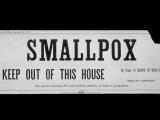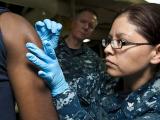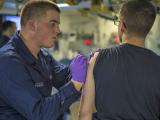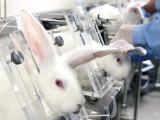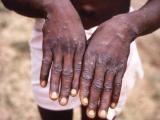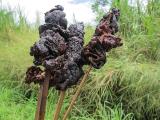Feb 19, 2003 (CIDRAP News) – Although federal health officials have not endorsed the use of an available safety needle in the current smallpox vaccination program, the Centers for Disease Control and Prevention (CDC) plans to take a careful look at the needle to determine if it should be used in the future, a CDC official says.
Univec, Inc., Farmingdale, N.Y., makes a bifurcated safety needle designed to prevent accidental needlestick injuries when administering the smallpox vaccine. The needle is not being used in the current campaign, however, because limited testing did not show that it is safer than the needles packaged with Dryvax, the vaccine in use now, said Dr Ray Strikas, director of smallpox preparedness and response activity in the CDC's National Immunization Program.
But the CDC is planning a more rigorous examination of the Univec needle, Strikas told CIDRAP News. "It's only appropriate, because it's a concern of a lot of people," he said. "We're trying to evaluate how best to do an evaluation of that [Univec] product in comparison with the older product."
The Needlestick Safety and Prevention Act of 2000 requires employers to evaluate available safety devices designed to prevent "sharps" injuries that could expose healthcare workers to bloodborne pathogens such as HIV. In mid-January, the American Nurses Association urged President Bush in a letter to delay the smallpox immunization program pending resolution of several issues, including "the utilization of safer bifurcated needles." Also in January, the Massachusetts Nurses Association issued a statement saying that the needles in the Dryvax kits "are unsafe and fail to comply" with the needlestick safety law.
Univec's bifurcated safety needle has a plastic sheath that slides forward after use to cover the two-pronged tip and prevent injury or accidental reuse, according to Herb Geller, the company's sales director. In addition, the needle is mounted in a syringe base, making it easier to handle than the needles in use now, he said.
"Ours is the only one that has that safety device," Geller told CIDRAP News. "After you give the immunization, you slide the sheath forward; it locks and covers the needle. This way there's no chance of getting a needlestick injury." The syringe base reduces the likelihood of fatigue that could cause vaccinators to make mistakes, he added. The conventional needles have no widened base, so holding them is like holding a nail, according to Geller. "Imagine poking someone 15 times and doing it for 200 people," he said. "Your fingers are going to get tired. Ours is easier to hold, so the one hundredth or two hundredth person will get the same immunization as the second or third."
Geller said the Univec needle won Food and Drug Administration (FDA) approval in February 2002.
The needles used with Dryvax are part of a kit, including the freeze-dried vaccine and a diluent, that the FDA approved in October 2002. Strikas said the licensing process "began before Univec's needle became available, and the process was well along and moved along without it."
Strikas read a prepared CDC statement that said, "CDC has determined that no other commercially available bifurcated needles are appropriate for administering the vaccine in this prepackaged [Dryvax] kit. The Occupational Safety and Health Administration has concluded that this determination is reasonable. Therefore employers are not required to evaluate other needles at this time. If in the future improved safety devices become available, employers will be responsible for evaluating whether any of those devices are appropriate for use at their workplace."
Strikas said the safety needle was evaluated by department-level staff members in the Department of Health and Human Services (HHS) and also by personnel in some state health departments. "Some limited evaluations were done, and it's not clear that the Univec needle offered an advantage," he said.
He declined to go into specifics about the findings and said he hasn't tested the needle himself. "OSHA agrees it's not clearly better, so there's no need to violate the license to use it with the current product, but it makes sense to see if there's a benefit" through further testing, he said.
Strikas pointed to data that indicate few needlestick injuries in smallpox vaccinations of laboratory workers with standard bifurcated needles. A report of a workshop held at Johns Hopkins University in 2001 says that the CDC received no reports of needlestick injuries associated with the vaccination of 8,000 lab workers between 1983 and 2001. However, there was no surveillance system for needlestick injuries, and all sharps devices pose some risk of injury, the report states. For example, a conventional fingerstick lancet, which is comparable to the bifurcated needle, has an injury rate of 12.5 per 100,000 uses, the report says. The workshop report is on the Web site of the Institute for Vaccine Safety at Johns Hopkins.
If tests show that the Univec needle or another safety needle is beneficial, it could possibly be used with one of the new, cell culture–derived smallpox vaccines that HHS is buying from the British company Acambis, Strikas said. HHS has ordered a total of 209 million doses of vaccine from Acambis.
Strikas couldn't say when the new evaluation of the Univec needle will be done. "We need to do it as soon as we can, but we haven't established a time frame or a specific process," he said.
States are currently vaccinating public health and hospital staff members who would serve on volunteer response teams in case of a smallpox outbreak. State plans call for vaccinating about 450,000 people in this first phase of the campaign. Up to 10 million more healthcare and emergency response workers are expected to be vaccinated in a second phase.
